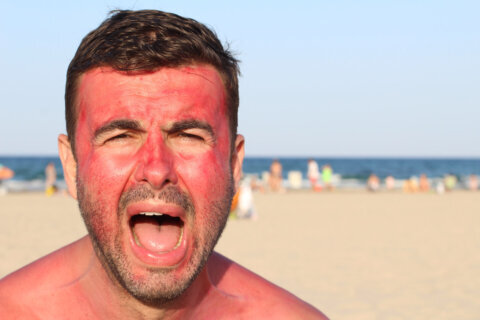Just as you should never drive or ride in a moving car without buckling your seat belt, you should never go out into the sun without applying sunscreen.
Seat belts, of course, can prevent you from becoming seriously injured or even killed in an accident. Similarly, the right kind of sunscreen — when applied properly — protects your skin from harmful sun rays that can cause a painful sunburn and potentially fatal skin cancer. It’s particularly important to apply sunblock during the summer months, when you’re likely to spend more time outdoors swimming, running or playing your favorite sport. No one wants to get skin cancer, a sunburn or become prematurely wrinkly. But when you step into a grocery store or pharmacy to get sunscreen, the dozens of sunscreen options can feel overwhelming.
Before buying sunscreen, there’s a host of issues to consider: What SPF level should I get? What do UVA and UVB mean? Do I need protection from either or from both? Which kind of sunscreen is best: lotion, stick or spray?
To provide some guidance, U.S. News teamed up with Pharmacy Times to survey 2,530 pharmacists to find out which sunscreen brands they recommend most often. Neutrogena came out on top, with 32 percent of the vote. Coppertone came in second, with 28 percent of the vote, and Banana Boat landed in third place, with 14 percent of the vote. No other brand reached double digits.
| Product Name | Percent of Pharmacists’ Votes | |
|
|
Neutrogena | 32% |
| Coppertone | 28% | |
| Banana Boat | 14% | |
| Bullfrog | 7% | |
| CeraVe | 6% | |
| Hawaiian Tropic | 4% | |
| Blue Lizard | 4% | |
| La Roche-Posay | 3% | |
| Babyganics | 2% | |
| Australian Gold | 1% |
So why is Neutrogena recommended more often than other options? “Neutrogena is a brand that patients and families are very familiar with,” says Dr. Lauren Taglia, a dermatologist at Northwestern Medicine Central DuPage Hospital in suburban Chicago. “I know [the company works] with skin care experts to research and develop new products.”
While Neutrogena came out on top in the survey, that doesn’t necessarily mean it provides superior protection compared to other sunscreens on the market. The majority of sunscreens contain the same ingredients approved by the Food and Drug Administration, notes Dr. William Wooden, director of operative services for IU Health in Indianapolis. Many sunscreen products can provide good protection, says Wooden, who does a lot of surgeries on patients with melanoma.
While the ingredients in different brands of sunscreen may be similar, the bottle labels are as varied as the vitamins in a nearby aisle. U.S. News asked several dermatologists to share their sun-shielding insights.
[See: Top Recommended Sunscreens.]
What’s the best SPF value?
SPF stands for sun protection factor. It measures the level of shielding a sunscreen provides from ultraviolet B exposure. This tells you how well a sunscreen will protect your skin from ultraviolet B radiation, which is the kind of solar energy that produces sunburns, says Dr. Mercedes Florez-White, a dermatologist and associate professor of dermatology at Florida International University Herbert Wertheim College of Medicine. SPF values range from as low as 2 to more than 100.
Some consumers are confused by what level of SPF they should get, says Dr. Jennifer Lucas, a dermatologist and dermatological surgeon at the Cleveland Clinic. Lucas and Florez-White recommend using sunscreen that has an SPF of at least 30 and is water-resistant and provides broad spectrum protection. Broad spectrum protection means the product shields your skin not just from ultraviolet B exposure, but also from ultraviolet A sun rays, which can lead to skin cancer, brown spots and premature wrinkling. SPF 30 sunscreen provides your skin with 97 percent protection from the sun’s harmful UVB rays, Lucas says. Sunscreens with a value higher than 30 provide just a small amount of additional protection. People with very fair skin should use an SPF 50 sunscreen, which would block 99 percent of the sun’s rays, Florez-White says.
The key is to apply the sunscreen on all of your skin that will be exposed to the sun, and reapply it at least every two hours, Lucas says. If you’re exercising vigorously and sweating or swimming in the water, reapply sunscreen more frequently. You should do so after engaging in any activity where the sunblock could be washed or wiped off, Lucas says.
[See: 7 Ways to Prevent Skin Cancer.]
Does skin color change what SPF you need?
Experts say that for the most part, the SPF 30 recommendation holds true for all skin types.
People with darker skin, who tend to tan rather than burn, need to use sunscreen as much as people with lighter complexions, Taglia says. She notes that legendary Jamaican singer Bob Marley died of a malignant melanoma that began on his foot. “Skin cancer doesn’t discriminate,” she says.
People with fair complexions need to be extra vigilant about applying and reapplying sunscreen, Lucas says. This would include many people with red or blonde hair and blue, green or gray eyes. “No matter what color skin you have, snow white or dark chocolate brown, you need to wear sunscreen with an SPF of 30 or higher that also provides broad-spectrum UV protection,” says Dr. Charles E. Crutchfield III, clinical professor of dermatology at the University of Minnesota Medical School, on the Twin Cities campus in Minneapolis, Minnesota. He’s also a dermatologist and medical director of Crutchfield Dermatology in Eagan, Minnesota. “Anyone can get skin cancer, regardless of age, gender or race,” Florez-White adds.
What’s the difference between UVA and UVB?
UVA and UVB refer to two different wavelengths of light, and both are harmful to your skin, says Dr. Tien Nguyen, a dermatologist at MemorialCare Orange Coast Medical Center in Fountain Valley, California. Basically, UVB refers to the spectrum of light that causes sunburn. Symptoms of UVB damage include redness, pain and swelling — sunburn, Nguyen says. “It’s painful, but the skin eventually heals with peeling,” he says.
Meanwhile, UBA wavelengths are associated with melanoma and long-term skin damage. “UVA penetrates deeper in the skin; that’s why it causes aging, wrinkles and skin cancer,” Nguyen says. UVA and UVB rays are why 20 percent of Americans get skin cancer, including melanoma and basal cell carcinoma, according to the Skin Cancer Foundation.
[See: Top Recommended Moisturizers with SPF.]
Does a more expensive sunscreen mean it’s more effective?
Experts are united in answering this question with a solid “no.”
“Sunscreens that are more expensive aren’t necessarily of higher quality,” Wooden says. So long as you have a sunscreen with an SPF of 30 or higher that provides broad spectrum protection and is water-resistant, you should be fine, he says. “Sunscreen with SPF 30 will give you adequate protection regardless of the price.”
Is a spray or lotion better?
People should choose the type of sunscreen they use based on the part of the body they’re applying it to and their personal preferences, Lucas says. “My favorite sunscreen is the one that people will consistently and regularly apply,” she says. Again, assuming you apply it correctly, you should be protected so long as the sunscreen is SPF 30, provides broad spectrum protection and is water-resistant. Be sure to apply the sunscreen at least 30 minutes before you go into the sun and reapply it liberally, at least every two hours depending on your activity. Be sure to put sunscreen on parts of your body that many people often neglect, such as your ears, the top or your feet and the back of your neck.
How much do you need to put on?
As a general rule, you should apply an ounce of sunscreen for the parts of your body exposed to the sun, the American Academy of Dermatology recommends. That’s about the amount that would fit into a shot glass. You should reapply the same amount each time, Crutchfield says. Larger people will likely need to use more sunscreen.
[See: Your Guide to Stylish Sun Protection.]
What else can you do to protect yourself?
Experts suggest an array of tactics to shield yourself from the harmful effects of the sun. These include avoiding sun exposure as much as possible during the peak hours of 10 a.m. to 4 p.m.; wearing a broad-brimmed hat that protects your face and ears; and staying in the shade whenever you can. You might also try sun-protective clothing made with lightweight fabrics with an ultraviolet protection factor of 50 and above. Such swimwear and accessories are available on a variety of websites.
More from U.S. News
6 Health Hazards to Watch Out for This Summer Other Than Skin Cancer
7 Tips for Coping With Sweaty Feet
9 Ways to Exercise in the Pool Beyond Swimming
How to Find the Best Sunscreen for You originally appeared on usnews.com
Update 06/12/18: This article was originally published on June 18, 2014 by Stephanie Steinberg. It has been updated.







